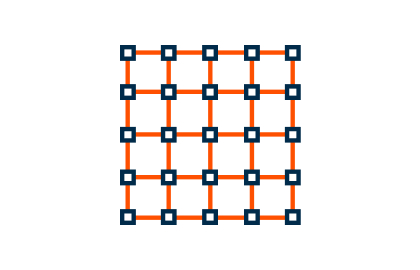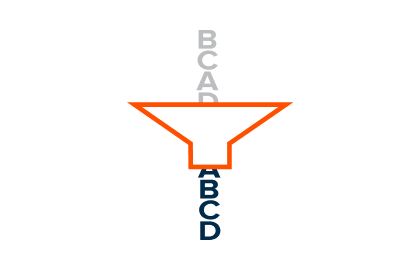Arteris FlexNoC Interconnect IP is the #1 on-chip fabric IP for SoCs. It is based on network-on-chip (NoC) technology and is used by most chip companies.
Enabling SoC Developers to Create Physically Valid NoCs Faster
The world’s #1 on-chip fabric is used by the world’s top semiconductor design teams as the backbone on-chip communications for chips targeting the fastest growing markets.
The latest generation FlexNoC 5 Interconnect with its integrated physical awareness technology, gives place and route teams a much better starting point while simultaneously reducing interconnect area and power consumption. FlexNoC 5 delivers up to 5X shorter turn-around-time versus manual physical iterations.
The combined use of FlexNoC and Ncore IP in an ASIC design delivers unparalleled performance optimization, scalability, and system integration, enabling robust cache coherence, efficient communication, and flexibility, leading to market differentiation and accelerated time-to-market.
The Most Complete Network-On-Chip Product
Everything design teams need to create the world’s best SoCs, faster
Flexible Topologies
FlexNoC is generated from simple elementary components which are combined by a powerful set of underlying algorithms and an intuitive GUI, making it possible to build any topology.
Small to Large SoCs
FlexNoC easily supports long cross-chip paths by leveraging source-synchronous communications and virtual channels.
Huge Bandwidth
FlexNoC drives performant on-chip data flow and access to off-chip memory by enabling multi-channel HBMx memory and high bandwidth data paths.
FlexNoC 5 Key Features
- Auto-timing closure assist
- Topology visualized directly on floorplan
- Multi-clock/power/voltage domains and power management with unit-level clock gating
- Multi-protocol support including AMBA 5 with QoS bandwidth regulator and limiter Enumerations
- General optimizations for lower area e.g. up to 30% for some NoC elements depending on configuration
- Native and user-defined firewall security
- Import and export to Magillem tools
- AMBA 5 support of DVM 8.1 (Distributed Virtual Memory)
- On-chip performance monitoring and debug
- Debug and trace with ATB 128b and timestamps
NoC Integration Automated Flow
Automated flow to leverage SoC connectivity information:
- Improved productivity with reduced process
- Better quality with early errors detections thanks to the checkers
Learn about Magillem Connectivity and Magillem Registers
FlexNoC Product Benefits
Higher Frequencies, Lower Latencies
Using built-in NoC performance analysis exploration tools
Lower Power Consumption
Advanced power management through clock gating, DVFS and GALS
Smaller Die Area
Fewer wires using optimal NoC transport layer
Speedy Timing Closure
Early physical awareness for faster convergence without re-designs
Easy Configuration
Through the intuitive FlexNoC 5 UI
Automated Verification
Saving hundreds of hours of work versus manual verification test benches
Shorter Schedules
Fewer iteration loops
Higher Profit
Reduced TTM from FlexNoC design efficiency savings
Read more about why we are unique on our NoC Technology page.
Sondrel has deployed Arteris FlexNoC interconnect IP across several customer SoC projects to great effect. Physical constraints have always been an important issue and are even more important below 16nm geometries. The latest FlexNoC 5 with its physical awareness technology, enables our RTL teams to verify that architectures meet physical constraints and provide a better starting point for our place and route team. We look forward to our continued cooperation with Arteris.
Sondrel
Graham Curren, CEO of SondrelUsing Arteris FlexNoC allows us to reduce development time and manage project risk. FlexNoC’s advanced quality-of-service and debugging features, combined with its multi-protocol support, allow Samsung SUHD TVs to reduce power consumption and die area for complex chips with more than 100 IP interfaces.
Samsung
HaeJoo Jeong, Vice President, Visual Display Business, Samsung Electronics
FlexNoC interconnect IP allowed us to dramatically increase MCU performance and functionality with no impact on die area while significantly decreasing power consumption.
Renesas
Andreas Papliolios, Director of IoT Silicon, Renesas Electronics America
As a result of our thorough evaluation, we know the Arteris FlexNoC interconnect IP will help us shorten development schedules and increase product performance, while simultaneously decreasing costs due to back-end wire routing congestion and timing closure issues.
Toshiba
Yukihiro Urakawa, Senior Manager, Logic LSI Division of Semiconductor & Storage Products Company, Toshiba Corporation
By incorporating Arteris FlexNoC interconnect IP into our development programs, we are able to streamline our overall design time. This solution also provides us with flexibility to create derivations of our offerings to quickly adapt to changing market needs.
Rambus
Mike Uhler, Vice President, Emerging Solutions Division, Rambus
TSMC chose to work with Arteris on the interposer based test chip program because its interconnect technology is ideally suited to addressing the SoC wire routing congestion and timing closure challenges. TSMC and Arteris are working together to make it easier for our joint customers to adopt these technologies.
TSMC
Suk Lee, Director of Design Infrastructure Marketing, TSMC
Our successful adoption of Arteris FlexNoC fabric IP has been straightforward, allowing us to more quickly architect and implement sophisticated systems-on-chip in less time and with better power consumption and performance.
Freescale
Fares Bagh, Vice President of R&D, Freescale
- FlexNoC 5 Datasheet
- Physically Aware Network-on-Chip Streamlines SoC Design Cycle | Electronic Design
- How Physically Aware Interconnect IP Bolsters SoC Design | EDN
- Considering Semiconductor Implementation Aspects Early During Network-On-Chip Development | Semiconductor Engineering
- Podcast: The Impact of Using a Physically Aware NoC with Charlie Janac | SemiWiki
- Meet the Next-Generation Network-on-Chip From Arteris | Design & Reuse
- Physically Aware NoCs | Semiconductor Engineering
- The Network-on-Chip Pioneer: How Arteris Enabling SoC Developers to Create Physically Valid NoCs Faster | EE Journal






